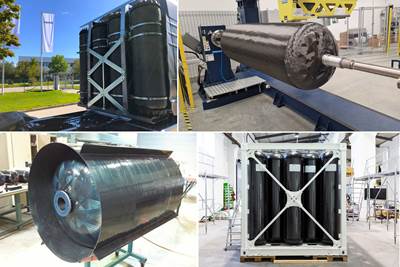Scorpius Type 5 tanks underpin second Intuitive Machines mission to the moon
IM-2 mission launch of Nova-C class lander on March 6 features composite propulsion system infrastructure that will enable successful lunar touchdown, exploration.
Share
PRIME-1 Nova C-class lunar lander. Source (All Images) | Scorpius Space Launch Co. (SSLC)
(SSLC, Torrance, Calif., U.S.) Type 5 composite propulsion tanks, feeding ’s (IM, Houston, Texas, U.S.) Nova-C lunar lander — are on their way to the Moon. Launch of the IM-2 mission took place at Cape Canaveral, Florida, on Feb. 26, 2025 at 4:15 p.m. PST. Expected touchdown on the lunar surface is March 6, 2025.
IM-2 represents a milestone in commercial lunar exploration, aiming to deliver advanced scientific instruments and technology demonstrations to the moon’s surface. The mission uses IM’s Nova-C class lander, which was launched aboard a SpaceX (Hawthorne, Calif., U.S.) Falcon 9 rocket from Launch Complex 39A at NASA’s Kennedy Space Center. The lander is destined for Mons Mouton, a plateau near the Moon’s South Pole, and will carry a suite of payloads, including NASA science experiments and commercial technology demonstrations.
A key component of this mission is the Polar Resources Ice Mining Experiment-1 (PRIME-1), a NASA initiative designed to search for water ice on the Moon. PRIME-1 will employ the regolith and ice drill for exploring new terrain (TRIDENT) to extract lunar soil, which will then be analyzed by the mass spectrometer observing lunar operations (MSOLO) to detect volatile substances. This experiment marks NASA’s first attempt to harvest resources from beneath the lunar surface, a critical step toward sustainable human exploration of the Moon and beyond.
Stringers and annular T-profiles for a wing box attachment.
SSLC has played a pivotal role in the development of the Nova-C lander, providing advanced composite pressure vessels essential for its cryogenic propulsion system (read “Type V pressure vessel enables lunar lander”). The Type 5 all-composite unibody Pressurmaxx liquid methane and liquid oxygen tanks are designed to withstand the rigors of space travel, ensuring the safe delivery of payloads to the lunar surface.
Pressurmaxx tanks were first used for IM’s IM-1 mission in February 2024, which successfully landed the Nova-C lander, Odysseus, near Malapert A in the Moon’s South Pole region. Since then, SSLC has made updates to the tank body’s integrated features that the company says “will put vehicle design solutions for spaceflight into the trade space for the first time.”
“Lighter and stronger are incremental improvements, but they are not game-changers,” says SSLC CEO Markus Rufer. “Converting secondary structure (a.k.a. parasitic mass) into primary load-bearing structure is transformational technology that will change how such vehicles are designed and what capabilities they can achieve.”
Such features are tank wall integrated and mechanically fused, so they don’t rely on adhesive properties of a bonding agent. These options include longitudinal stringers, circumferential stiffeners, engine mounts, attachments, propellant management systems (slosh baffles, anti-vortex devices, positive expulsion systems) and carbon fiber fluid lines.
Carbon fiber LOX downcomer line for a launch vehicle.
Pressurmaxx pressure vessels are qualified for temperatures ranging from -321°F to 160°F. Chemical compatibilities include petroleum-based fuels (kerosene and alcohol-based fuels) as well as cryogens (such as liquid oxygen, liquid nitrogen, liquid methane), various gases (methane, helium, oxygen, nitrogen) and propellants (turpentine, hydrazine and HAN AF-M-315E green propellant).
Besides validated performance in space, SSLC says these features have already enabled applications in medical, energy, maritime, liquified natural gas transportation, superconducting transformer technology, aviation and are currently in test for liquid hydrogen applications.
The upcoming IM-2 mission signifies a continued commitment to advancing lunar exploration and developing the infrastructure necessary for a sustained human presence on the Moon.
Related Content
Honda begins production of 2025 CR-V e:FCEV with Type 4 hydrogen tanks in U.S.
Model includes new technologies produced at Performance Manufacturing Center (PMC) in Marysville, Ohio, which is part of Honda hydrogen business strategy that includes Class 8 trucks.
Read MoreInfinite Composites: Type V tanks for space, hydrogen, automotive and more
After a decade of proving its linerless, weight-saving composite tanks with NASA and more than 30 aerospace companies, this CryoSphere pioneer is scaling for growth in commercial space and sustainable transportation on Earth.
Read MorePolar Technology develops innovative solutions for hydrogen storage
Conformable “Hydrogen in a Box” prototype for compressed gas storage has been tested to 350 and 700 bar, liquid hydrogen storage is being evaluated.
Read MoreBraided thermoplastic composite H2 tanks with co-consolidated molded boss areas to fit EV battery space
BRYSON project demonstrates possible designs, automated manufacturing and low permeability concepts, including EVOH liner and novel PPA matrix.
Read MoreRead Next
Scorpius Space Launch Company unveils carbon fiber cryogenic high pressure tanks
SSLC’s vessels are built with carbon fiber materials and the company’s proprietary Sapphire 77 cryogenic resin system and feature anti-slosh baffles.
Read MoreComposites end markets: Pressure vessels (2024)
The market for pressure vessels used to store zero-emission fuels is rapidly growing, with ongoing developments and commercialization of Type 3, 4 and 5 tanks.
Read MoreBlue Ghost lunar lander makes successful soft landing on the Moon
After a 45-day trip, Firefly Aerospace’s first landing attempt landed Blue Ghost in an upright, stable configuration, followed by the start of surface operations.
Read More









